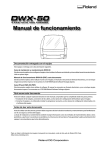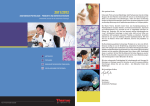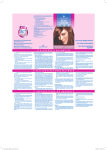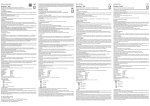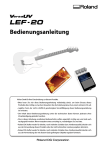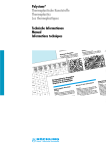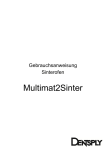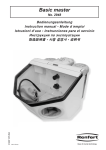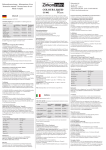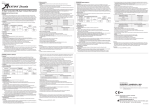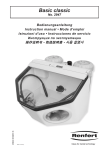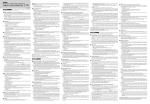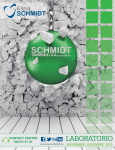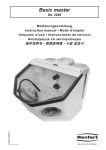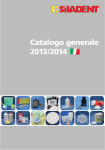Download Zirkon BioStar S 0124 - SILADENT Dr. Böhme & Schöps GmbH
Transcript
Zirkon BioStar (weiß opak, Colour) Zirkon BioStar Z (weiß transluzent) Zirkon BioStar HT (hoch transluzent weiß, HT Colour) Zirkon BioStar S 0124 Gebrauchsanweisung Bezeichnung und allgemeine Beschreibung Gerüstkeramik Typ II, Klasse 6 gemäß DIN EN ISO 6872. Alle Zirkon BioStar Varianten sind zahnärztliche Werkstoffe (Halbzeuge) aus tetragonal yttriumstabilisiertem, vorgesintertem Zirkoniumdioxid zur frästechnischen Herstellung von Kronen- und Brückengerüsten auf kommerziellen CAD/CAM–Systemen oder handgeführten Kopierfräsmaschinen mit ausgezeichneter Biokompatibilität und hohen Festigkeiten hinsichtlich auftretender Zug- und Druckbeanspruchung. Die vorgesinterten Rohlinge lassen sich sehr gut bearbeiten und zeigen eine ausgezeichnete Kantenstabilität. Durch das spezielle Herstellverfahren wird auch über verschiedene Chargen hinweg eine äußerst konstante Brennschwindung erreicht, so dass in den meisten Fällen keine Änderung des Vergrößerungsfaktors bei der CAD/ CAM-Einheit erforderlich ist. Die Bearbeitung soll ausschließlich mit diamantbesetzten Schleifwerkzeugen oder mit Hartmetallwerkzeugen erfolgen. Werkstoffvarianten Die Werkstoffvarianten unterscheiden sich durch einen unterschiedlichen Gehalt an Aluminiumoxid bezüglich des nach der Endsinterung erreichbaren Festigkeitswertes, der Beständigkeit gegen hydrothermale Alterung sowie in der Art der Weißfärbung und der Transluzenz. Zirkon BioStar Colour (500, 800, 1000, 1333, 2000) und Zirkon Biostar HT Colour (100, 200, 500, 800, 1000) sind durch geringe Zugaben eines Pigmentes bereits in verschiedenen Zahnfarben eingefärbt. Zirkon BioStar HT ist ein Werkstoff mit einem reduzierten Al2O3 -Gehalt und einer speziellen Ausgangskorngröße. Durch diese besondere Einstellung zeigt dieser Werkstoff ein optimales Verhältnis von höchster Transluzenz und guter hydrothermaler Beständigkeit. Durch eine etwas höhere Weißdichte eignet sich dieser Werkstoff auch zur Herstellung von vollanatomischen Kronen, die nach dem Sinterbrand nicht beschichtet werden, sondern nur vor der Sinterung leicht coloriert werden. Dadurch kann der Zahnarzt oder Zahntechniker das für den jeweiligen Anwendungsfall ideale Grundmaterial auswählen. Auf Grund der hohen Festigkeitswerte sind alle Materialien auch für mehrgliedrige Seitenzahnbrücken geeignet. Alle Werkstoffvarianten wurden von einem akkreditierten Prüflabor bezüglich der biologischen Verträglichkeit untersucht und für die Anwendung im Dentalbereich als vorzüglich geeignet eingestuft. Indikation Alle Zirkon BioStar Produkte sind geeignet zur Herstellung von Zahnersatz in Form von Kronen und Brücken (sowohl in Form von Kappen, Zwischengliedern und in vollanatomischer Gestaltung mit max. zwei Brückengliedern im Seitenzahnbereich und max. 4 Brückengliedern im Frontzahnbereich), bis hin zu Stegkonstruktionen, Teleskopen, Marylandbrücken, Inlays, Onlays, Freiendbrücken (mit max. 2 Brückengliedern), und individuellen Implantat-Abutments. Druckdatum: 05/2013 Kontraindikationen Bei Bruxismus, unzureichendem Zahnhartsubstanzangebot oder nicht ausreichendem Platzangebot ist die Verwendung von vollkeramischen Kronen und Brücken nicht oder nur bedingt zu empfehlen. Das gleiche gilt bei unzureichender Mundhygiene oder unzureichender Koordinationsfähigkeit der Kaubewegungen. Bei nicht zufriedenstellenden Präparationsergebnissen oder einer unsachgemäßen Herstellung darf eine vollkeramische Krone oder Brücke ebenfalls nicht verwendet werden. Präparationshinweise Bei den Angaben zu den Mindest-Wandstärken in der nachfolgenden Tabelle handelt es sich nur um Anhaltswerte. Die Entscheidung über die Art und die Ausführung der Präparation obliegt dem Zahnarzt und dem Zahntechniker. SILADENT Dr. Böhme & Schöps GmbH DE-38644 Goslar . Im Klei 26 Tel.: +49 (0) 53 21/37 79-0 Fax: +49 (0) 53 21/38 96 32 [email protected] www.sbs-dental.de 1 Die Wandstärke sollte mindestens Seitenzähne Frontzähne Pfeilerkronen von Brückengerüsten mit 2 Zwischengliedern betragen: okklusal 1,5 mm inzisal/okklusal 0,7 mm zirkulär 0,5 mm zirkulär 0,5 mm inzisal/okklusal 1,0 mm zirkulär 0,7 mm Die Konnektorenfläche sollte mindestens betragen: Frontzahngerüst mit einem Zwischenglied Frontzahngerüst mit zwei Zwischengliedern Seitenzahngerüst mit einem Zwischenglied Seitenzahngerüst mit zwei Zwischengliedern 7 9 9 12 mm2 mm2 mm2 mm2 Fräsbearbeitung Die Fräsbearbeitung kann mit den meisten kommerziell erhältlichen CAD/CAM Fräsmaschinen oder handgeführten Kopierfräsmaschinen durchgeführt werden. Die Auswahl der Fräser und der erforderlichen Drehzahlen richtet sich nach der Bedienungsanleitung des Maschinenherstellers. Um Fleckenbildung oder Festigkeitsminderungen zu vermeiden, soll der Rohling während der Ausarbeitung und dem zugehörigen Handling nach Möglichkeit nicht mit Flüssigkeiten (Wasser, Öle) oder Fetten (Handcreme) in Kontakt kommen. Eine Nassbearbeitung der Dental Blanks im vorgesinterten Zustand ist prinzipiell möglich, erfordert aber ein vollständiges Trocknen der Restauration vor der Sinterung. Die Trocknung kann in einem Trockenschrank bei ca 80°C oder unter einer Infrarotlampe durchgeführt werden. Alternativ dazu kann das Brennprogramm im unteren Temperaturbereich entsprechend schonend gestaltet werden. Einkerbungen, scharfe Kanten oder kleine Beschädigungen auch an der Unterseite des Gerüstes können die Festigkeit der fertig gesinterten Arbeit reduzieren. Deswegen ist auf eine gute Verrundung und Glättung bereits bei der Fräsbearbeitung zu achten. Einfärben Die Gerüste können bei Bedarf mit den handelsüblichen und für Zirkonoxidkeramik zugelassenen Färbelösungen an die gewünschte Zahnfarbe angepasst werden. Um gleichmäßige Ergebnisse zu erhalten ist darauf zu achten, dass das Gerüst vor dem Färben vollkommen sauber, fettfrei und trocken ist. Für die weiteren Arbeitsabläufe sind die Anweisungen der Hersteller der Färbelösungen zu beachten. Rohlinge aus Zirkon BioStar Colour und Zirkon BioStar HT Colour sind bereits eingefärbt und müssen in der Regel nicht mehr nachbehandelt werden. Sinterung Die Sinterung der Präparationen kann in allen handelsüblichen und für Zirkonoxidkeramik geeigneten Ofenanlagen durchgeführt werden. Die Betriebsanweisungen der jeweiligen Anlagenhersteller sind dabei zu beachten. Die Gerüste schwinden beim Sintern um etwa 20 %. Die dazu erforderliche Bewegung ist nur möglich, wenn die Einzelkronen oder Gerüste auf entsprechenden Sinterlagerungen gebrannt werden. Das Gerüst soll so gelagert sein, dass eine Berührung mit anderen Gerüsten oder dem Sinterträger ausgeschlossen ist, damit es nicht zu Verformungen kommt. Die Sinterträger sollen mindestens alle zwei Wochen nach den Anweisungen des Herstellers auf Ebenheit geprüft werden. Die Lagerung von Front- und Seitenzahngerüsten ab drei Gliedern sollte generell mit der okklusalen Seite nach oben erfolgen. Wenn Sinterdrähte oder –stifte verwendet werden, muss darauf geachtet werden, dass der Käppchenwandbereich nicht kontaktiert wird. Alternativ dazu kann das Sintern in einer Sinterschale erfolgen, in der die Restauration in ein geeignetes Granulat eingebettet wird. Als Granulat eignen sich unter anderem ZrO2 – Sinterkugeln. Bei der Verwendung von Sinterschalen und Granulat wird das Gerüst mit der okklusalen Seite nach unten in das Granulat gelegt. Die jeweiligen Brennzyklen können in 6 bis 12 Stunden durchgefahren werden. Ob diese hohen Aufheizraten im jeweiligen Sinterofen möglich sind und von den jeweiligen Restaurationen noch ohne Verzug oder Rissbildung toleriert werden, muss im Einzelfall vom Zahnlabor geprüft und festgelegt werden. Die Schwindung der Präparationen aus Zirkon BioStar ist durch das spezielle Herstellungsverfahren sowohl innerhalb der einzelnen Materialchargen als auch über mehrere Chargen hinweg äußerst konstant. Die exakten Werte teilen wir Ihnen bei jeder Lieferung mit. Bitte beachten Sie die Hinweise / Parameter aus der Gebrauchsanweisung des jeweiligen Geräteherstellers. Zirkon BioStar HT (hoch transluzent) Sinterung: Zum Erreichen einer optimalen Transluzenz muss beim Sintern von Kronen und Brücken aus Zirkon BioStar HT (hoch transluzent) eine eigene Sinterschale und eigene ZrO2-Sinterperlen verwendet werden. In dieser Sinterschale dürfen vorher keine anderen Zirkonoxid Werkstoffe gesintert werden. Einfärben: Rohlinge aus Zirkon BioStar HT können auf Grund der höheren Weißdichte vor dem Sinterbrand mit den dafür geeigneten Malfarben coloriert werden und eignen sich deswegen für die Herstellung von vollanatomischen, verblendungsfreien und monolithischen Restaurationen. 2 Zirkon BioStar S - Zusätzliche Hinweise zur Gebrauchsanweisung Anleitung zur Verwendung von Zirkon BioStar S in Ihrem Sirona inLab® oder inLab® MCXL System Allgemeine Verarbeitungshinweise: Grundsätzlich können Sie die Zirkon BioStar S Blöcke verarbeiten, wie andere Blöcke Ihrer bisherigen Lieferanten auch. Programmierung des Sirona inLab® oder inLab® MCXL Systems: 1. Setzen Sie den erforderlichen Zirkon BioStar S Block wie gewohnt ein. 2. Wählen Sie in Ihrem Gerät aus der „VITA In-Ceram®YZ Blockauswahl“ das geeignete Blockformat zur Verarbeitung aus. 3. Geben Sie den, auf der äußeren Verpackung aufgeklebten „Z-Code“ vollständig, auch mit „*“, z.B.: *Z24912A ein. 4. Starten Sie den Fräsvorgang VITA In-Ceram®YZ, Sirona inLab® und inLab® MCXL Systems sind eingetragene Warenzeichen der Hersteller. Bitte beachten Sie bei Zirkon BioStar HT Colour: Entweder Sie sintern mit einer Endtemperatur von 1.450 °C und halten diese für 3,5 Std. oder Sie sintern mit einer Endtemperatur von 1.550 °C und halten diese für nur 0,5 Std. Die sonstigen Sinterparameter entsprechen der nachfolgenden Tabelle. Die erzielbaren Transluzenseffekte sind bei beiden Vorgehensweisen gleichwertig. Die empfohlenen Sintertemperaturen betragen, je nach Material, für: Sinterprogramm für Zirkon BioStar weiß opak / HT (weiß) / Colour / S Einzelkrone Aufheizrate auf 900 °C °C / Min. Haltezeit bei 900 °C Aufheizrate bis Endtemperatur 1450 °C °C / Min. Haltezeit bei Endtemperatur 1450 °C Abkühlrate auf 900 °C °C / Min. Haltezeit bei 900 °C Abkühlrate bis 200 °C °C / Min. Gesamtzeit h 3 – 4 gldrg. Brücken °C Min. größer 4 gldrg. und zirkuläre Brücken °C Min. °C Min. 15 59 12 73 8 110 900 5 900 15 900 30 15 36 12 46 8 69 1450 30 1450 120 1450 120 10 55 5 110 4 138 900 5 900 10 900 20 10 70 5 135 4 175 4 h 20 min. 8 h 29 min. 11 h 02 min. Sinterprogramm für Zirkon BioStar Z weiß transluzent Einzelkrone Aufheizrate auf 900 °C °C / Min. Haltezeit bei 900 °C Aufheizrate bis Endtemperatur 1500 °C °C / Min. Haltezeit bei Endtemperatur 1500 °C Abkühlrate auf 900 °C °C / Min. Haltezeit bei 900 °C Abkühlrate bis 200 °C °C / Min. Gesamtzeit h 3 – 4 gldrg. Brücken °C Min. größer 4 gldrg. und zirkuläre Brücken °C Min. °C Min. 15 59 12 73 8 110 900 5 900 15 900 30 15 40 12 50 8 75 1500 30 1500 120 1500 120 10 60 5 120 4 150 900 5 900 10 900 20 10 70 5 135 4 175 4 h 29 min. 8 h 43 min. 11 h 20 min. 3 Da die Temperaturmessung in jedem Ofen zu etwas anderen Ergebnissen führen kann, ist im Einzelfall eventuell auch eine Anpassung der individuellen Ofentemperatur durch einen Versuchsbrand erforderlich. Beim Öffnen des Sinterofens sollte ein massiver Temperatursturz vermieden werden, da sich das Öffnen des temperierten Ofens sowohl negativ auf den Ofen, als auch auf die Sinterprodukte negativ auswirken und damit die Produkte schädigen kann. Je nach Ofentyp können sich hierfür unterschiedliche Werte ergeben. Bei unseren Zirkonprodukten sollte der Ofen möglichst nicht über 250°C geöffnet werden. Bitte beachten Sie die Anleitung des Ofenherstellers. Zahngerüste und Kronen aus Zirkonoxid sollten in einem Ofen gebrannt werden, der nur für diese Produkte verwendet wird. Werden im gleichen Ofen auch Restaurationen aus anderen keramischen Werkstoffen gebrannt oder Flusskeramiken eingebrannt, kann dies zu Beeinträchtigung des Sinterverhaltens oder zu lokalen Verfärbungen führen. Falls das Brennen von unterschiedlichen Werkstoffen im gleichen Ofen nicht vermieden werden kann, ist vor dem Brennen der Zirkonoxidkeramik ein Leerbrand bei Maximaltemperatur zu empfehlen. Verblendung der Gerüste Kronen und Brückengerüste aller Zirkon BioStar Varianten können mit handelsüblichen Verblendkeramiken für Gerüste aus Zirkonoxid verblendet werden. Die von den jeweiligen Herstellern für Zirkonoxid freigegebenen Verblendungen sind bezüglich des Wärmeausdehnungskoeffizienten und der werkstofflichen Verbundbildung angepasst. Der nach DIN EN ISO 6872 ermittelte WAK von Zirkon BioStar beträgt 10,7 x 10 -6 K-. Ob eine thermische oder chemische Vorbehandlung der gesinterten Konstruktion vor der Verblendung empfohlen wird, ist den Beschreibungen der Hersteller des Verblendmaterials zu entnehmen. Nachbearbeitung nach der Endsinterung Bei einer eventuell erforderlichen Nachbearbeitung der gesinterten Konstruktionen soll dies nur unter Verwendung einer Wasserkühlung bei der Schleifbearbeitung erfolgen. Dadurch werden lokale Überhitzungen und Schädigungen des Materials vermieden. Angaben zur Lagerung Die Zirkonoxid-Rohlinge sollen bei normalen Bedingungen bezüglich Temperatur und Luftfeuchtigkeit („kühl und trocken“ entsprechend 10 °C bis 35 °C und 30 bis 70% rel. Feuchte) gelagert werden. Es ist keine Veränderung der Materialeigenschaften auch bei längerer Lagerung zu erwarten. Die Rohlinge sollen keiner direkten Sonnenbestrahlung ausgesetzt werden. Die in der Verarbeitungsanleitung angegebenen Werte für Wandstärken von Kronen- oder Brückengerüsten sowie Aufheizraten von Sinterprogrammen wurden in der Praxis erprobt und haben sich vielfach bewährt. Dennoch kann es durch besondere Größen oder ungleiche Materialansammlungen erforderlich werden, dass die Verarbeitungsbedingungen auf die spezielle Restauration angepasst werden müssen. Eine Garantie für eine sachgerechte Erstellung kann daher nicht aus den aufgezeigten Parametern hergeleitet werden. Sicherheitshinweis Die Inhalation des Keramikstaubs kann die Atemwege reizen. Kontakt mit Haut und Augen kann Irritationen hervorrufen. Metallstaub ist gesundheitsschädlich. Beim Ausarbeiten und Abstrahlen ist eine geeignete Absaugung und Atemschutz zu benutzen! Entsorgung von Materialresten Reststücke der Rohlinge und natürlich auch gesinterte Teile aus Zirkon BioStar sind als chemisch vollkommen inert einzustufen und können ohne besondere Auflagen entsorgt werden. Nebenwirkungen Wie z. B. Allergien gegen Zirkondioxid sind in seltenen Einzelfällen möglich. Wechselwirkungen nicht bekannt. Gegenanzeigen Bei erwiesenen Unverträglichkeiten und Allergien gegenüber Zirkondioxid. 4 Werkstoffdatenblätter für die unterschiedlichen Zirkon BioStar Varianten: Chemische Formel:ZrO² / Y²O³ / Al²O³ Chemische Bezeichnung: Yttriumstabilisiertes tetragonales Zirkondioxid Farbe: weiß opak / weiß transluzent / eingefärbt / eingefärbt hoch transluzent Produktbeschreibung: vorgesinterte Halbzeuge aus Zirkondioxid für zahnmedizinische Anwendungen Chemische Zusammensetzung Zirkon BioStar Z Zirkon BioStar Zirkon BioStar Colour Zirkon BioStar HT weiß Zirkon BioStar HT Colour ZrO² / HfO² / Y²O³ wt% > 99,0 > 99,0 > 99,0 > 99,0 > 99,0 Y ² O³ wt% 5,15 +/- 0,20 5,15 +/- 0,20 5,15 +/- 0,20 5,15 +/- 0,20 5,65 +/- 0,30 HfO² wt% < 5,0 < 5,0 < 5,0 < 5,0 < 5,0 Al²O³ wt% < 0,1 < 0,3 < 0,3 < 0,1 < 0,1 Fe²O³ wt% < 0,1 < 0,1 < 0,3 < 0,1 < 0,1 Na²O wt% < 0,04 < 0,04 < 0,04 < 0,04 < 0,04 Dichte g/cm³ > 6,05 > 6,05 > 6,00 > 6,05 > 6,05 Biegefestigkeit MPa 1.000 +/- 200 1.200 +/- 200 1.000 +/- 200 1.000 +/- 200 1.000 +/- 200 E-Modul Gpa 210 210 210 210 210 WAK 10-6 1/K 10,7 10,7 10,7 10,7 10,7 keine keine keine keine keine < 0,2 < 0,2 < 0,2 < 0,2 < 0,2 Physikalische Werkstoffdaten nach der Endsinterung Offene Porosität Radioaktivität 238 Aktivität U, 226 Ra, 232 Th Bq/g entspricht den Anforderungen der ISO 6872 und der ISO 13356.2 Biokompatibilität und Chemische Löslichkeit: Cytotoxizität unbedenklich DIN EN ISO 10993 / DIN EN ISO 9363 Chemische Löslichkeit unter Nachweisgrenze DIN EN ISO 10903 / DIN EN ISO 6872 (< 1 µg/cm²) Die angegebenen Eigenschaftswerte sind typische Werte und gelten nur für die Probekörper, an denen sie gemessen wurden. Eine Übertragung auf andere Formen ist nur bedingt zulässig. Die Werte sind daher als Richtwerte zu verstehen. Bei Fragen: SILADENT-Anwendungstechnik (Tel.: 0 53 21 37 79 25 / 26) oder unsere Mitarbeiter im Außendienst. Stand der Information: 05/2013 5 Zirkon BioStar (white opaque, Colour) Zirkon BioStar Z (white translucent) Zirkon BioStar HT (high translucent white, HT Colour) Zirkon BioStar S 0124 Instructions for use Name and general description Porcelain frames type II, class 6 accord. DIN EN ISO 6872. All Zirkon BioStar materials are dental materials (semi-finished products) made of yttrium stabilized, pre-sintered zirconium dioxide for milled production of crowns and bridge frameworks on commercial CAD/CAM systems or hand-operated copy-milling machines with outstanding biocompatibility and high resistance against tension and pressure. The pre-sintered blanks are eminently suitable for machining and have excellent edge stability. On account of the special production process, extremely constant firing shrinkage is achieved, even over different batches, meaning that in most cases it is not necessary to adjust the enlargement factor on the CAD/CAM unit. Only diamond-charged grinding tools or hard metal tools are to be used for machining. Material types The material types differ regarding the strength value achievable after the final sintering and contain a different amount of aluminum oxide. They differ in the manner of whiteness and translucency and both show a different resistance against hydrothermal aging. Zirkon BioStar Colour (500, 800 1000, 1333, 2000) and Zirkon Biostar HT Colour (100, 200, 500, 800, 1000)are already persistent coloured in the pre-sintered stage. Consequently, the dental surgeon or dental technician can select the ideal base material for the respective case. On account of the high strength values, both materials are also suitable for multiple-element posterior bridgework. Zirkon BioStar HT is a raw material with a reduced Al2O3 content and a special initial grain size. Due to this arrangement this raw material produces an optimal relation of maximum translucency and an excellent hydrothermal consistency. Due to a higher density before sintering, this raw material is also suitable for the production of fully anatomical crowns, not to be layered over after the sintering process, but just slightly coloured before sintering instead. If required, additional physical and chemical key values are referred in our material data sheets. All material types were tested by an accredited testing laboratory regarding biological compatibility and classified as eminently suitable for use in the dental sector. Indication All Zirkon BioStar products are suitable for the construction of dental restaurations including crowns and bridges (both crowns and pontics as well as fully anatomic restaurations with a maximum of two pontics in lateral areas and four pontics in anterior areas) or milled substructures, telescopic crowns, Maryland bridges, inlays, onlays, open end bridges (with a maximum of two pontics) and individual implant abutments. Contraindications In the case of bruxism, inadequate hard tooth structure or insufficient space, the use of full ceramic crowns and bridges is not recommended or only advised in some cases. The same applies in the case of inadequate oral hygiene or inadequate coordination of masticatory movements. A full ceramic crown or bridge may also not be used in the event of unsatisfactory preparation results or in the case of production faults. Preparation information The minimum wall strength values in the following table are merely reference values. The decision on the manner and undertaking of the preparation is the responsibility of the dental surgeon and dental technician. SILADENT Dr. Böhme & Schöps GmbH DE-38644 Goslar . Im Klei 26 6 Tel.: +49 (0) 53 21/37 79-0 Fax: +49 (0) 53 21/38 96 32 [email protected] www.sbs-dental.de The wall strength should be at least: Posterior teeth Anterior teeth Abutment crowns of bridge frameworks with 2 pontics occlusal 1.5 mm incisal/occlusal 0.7 mm circular 0.5 mm circular 0.5 mm incisal/occlusal 1.0 mm circular 0.7 mm Minimum connector areas: Anterior bridge framework Anterior bridge framework Posterior bridge framework Posterior bridge framework with with with with 7 9 9 12 one pontic two pontics one pontic two pontics mm2 mm2 mm2 mm2 Milling Milling can be undertaken with most commercially available CAD/CAM milling machines or hand-operated copymilling machines. The machine manufacturer’s manual should be consulted regarding the selection of the milling cutters and the necessary revolutions/minute. In order to avoid staining or a loss of strength, the blank should if possible not come into contact with liquids (water, oils) or fats (handcream) during milling and related handling of the blank. Wet machining of the dental blanks in their pre-sintered state is in principle possible, but does require that the restoration be dried completely before sintering. Drying can be undertaken in a drying chamber at approx. 80°C or under an infrared lamp. Alternatively, a low-temperature firing program can be selected which will not damage the blank. Notches, sharp edges or slight damage, also on the underside of the framework, may reduce the strength of the completed sintered work. Consequently, it is already important to ensure that surfaces are well rounded and smooth when milling. Colouring If required, the frameworks may be matched to the desired tooth colour with the standard colouring solutions which are licensed for zirconium oxide ceramics. In order to achieve even results, it must be ensured that the framework is completely clean, fat-free and dry before colouring. The instructions of the manufacturers of the colouring solutions should be followed for the further work procedures. Sintering The sintering of the preparations can be undertaken in all standard furnaces which are suitable for zirconium oxide ceramics. The manufacturer’s operating instructions must be followed in all cases. When sintered, the frameworks shrink by around 20 %. The required movement is only possible if the individual crowns or frameworks are fired on corresponding sinter bearings. The framework must be positioned in such a way that it cannot come into contact with other frameworks or the sinter carrier in order to avoid any deformation. The sinter carriers must be examined at least every two weeks in accordance with the manufacturer’s instructions to ensure that they are level. Anterior and posterior dental frameworks with three or more elements should generally be positioned with the occlusal side upwards. If sintering wires or pegs are used, it must be ensured that there is no contact with the cap wall area. Alternatively, sintering may be carried out in a sintering crucible in which the restoration is embedded in suitable granular material. One suitable type of granules are ZrO2 sintering spheres. When using sintering crucibles and granules, the framework is placed in the granules with the occlusal side downwards. The respective firing cycles can be completed in 8 to 12 hours. The dental laboratory must check and determine in the individual case whether these high heating rates are possible in the respective sintering furnace and whether they are still tolerated by the respective restoration without distortion or cracking. The shrinkage of the preparations made of Zirkon BioStar and Zirkon BioStar Z remains at an extremely constant level, both within the individual batches and over several batches, on account of the special production process. We shall advise you of the exact values with each delivery. Please refer to the information/parameters in the instructions for use issued by the manufacturer of the equipment you are using. Zirkon BioStar HT (high translucent) Sintering: To achieve an optimum translucency, the use of a fresh sintering bowl as well as sintering ZrO2-beads is strongly recommended for the process of sintering Zirkon BioStar HT (high translucent). The sintering bowl must not have been used for sintering other zirconia materials previously. Colouring: Zirkon BioStar HT blanks may due to their higher density before sintering, be stained before the sintering process using appropriate stains and are therefore suitable for the production of fully anatomical and monolithical restaurations without any over-layering or veneering. 7 Zirkon BioStar S - Additional information for the instructions for use Instructions for the use of Zirkon BioStar S in your Sirona inLab® or inLab® MCXL system General information: Basically, you can use your Zirkon BioStar S blocks as other blocks for your Sirona® system. Programming of the Sirona inLab® or inLab® MCXL System: 1. Place the Zirkon BioStar S block as usual. 2. Chose from the seleccion of blocks ”VITA In-Ceram®YZ“ the corresponding block size for the process. 3. Enter the “Z-Code” indicated on the package completely, including ”*“, as for instance: *Z24912A. 4. Iniciate milling VITA In-Ceram®YZ, Sirona inLab® and inLab® MCXL Systems are registered trademark of the manufacturers. Please, consider when using BioStar HT Colour: Either sinter using an final temperature of 1.450 ºC with a time of maintenance of 3.5 h, or 1.550 ºC for 30 min, alternatively. All others values match the following chart. The achievable effects of translucency are not affected by either method. Depending on the material, the recommended sintering temperatures are: Sintering program for Zirkon BioStar white opaque / HT (white) / Colour / S single crown Preheating rate up to 900 °C °C / min. Holding time at 900 °C Preheating rate to final temperature of 1.450 °C Holding time at final temperature of 1.450 °C Cooling rate down to 900 °C °C / min. Holding time at 900 °C Cooling rate down to 200 °C Total time in h bridge of 3 - 4 pieces brigde of > 4 pieces & circular bridges °C min. °C min. °C min. 15 59 12 73 8 110 900 5 900 15 900 30 15 36 12 46 8 69 1450 30 1450 120 1450 120 10 55 5 110 4 138 900 5 900 10 900 20 10 70 5 135 4 175 4 h 20 min. 8 h 29 min. 11 h 02 min. Sintering program for Zirkon BioStar Z white translucent single crown Preheating rate up to 900 °C °C / Min. Holding time at 900 °C Preheating rate to final temperature of 1.500 °C Holding time at final temperature of 1.500 °C Cooling rate down to 900 °C °C / min. Holding time at 900 °C Cooling rate down to 200 °C Gesamtzeit h 8 bridge of 3 - 4 pieces brigde of > 4 pieces & circular bridges °C min. °C min. °C min. 15 59 12 73 8 110 900 5 900 15 900 30 15 40 12 50 8 75 1500 30 1500 120 1500 120 10 60 5 120 4 150 900 5 900 10 900 20 10 70 5 135 4 175 4 h 29 min. 8 h 43 min. 11 h 20 min. As the temperature measurement in every furnace can give somewhat different results, it may possibly be necessary in an individual case to adjust the specific furnace temperature by carrying out a test firing cycle. Massive drops in temperature when opening the sintering furnace should be avoided, as opening the heated furnace can have a negative effect on both the furnace and the sintered products, damaging the restoration. The temperatures vary according to furnace type. With our zirconia products, avoid opening the furnace at temperatures above 250°C. Please refer to the instructions provided by the furnace manufacturer. Dental frameworks and crowns made of zirconium oxide should be fired in a furnace which is only used for these products. If additionally restorations made of other ceramic materials are fired or if liquid ceramics are baked in the same furnace, this may impede the sintering behavior or result in localized discolouration. If the firing of different materials in the same furnace cannot be avoided, then an empty firing cycle at maximum temperature is recommended before firing zirconium oxide ceramics. Facing of the frameworks Crowns and bridge frameworks made of Zirkon BioStar materials may be faced with standard facing ceramics for frameworks made of zirconium oxide. The facings passed by the respective manufacturers for zirconium oxide are adapted regarding the thermal expansion coefficient and the material bonding. Please consult the descriptions of the manufacturers of the facing material for information regarding whether thermal or chemical pretreatment of the sintered construction is recommended before facing. Finishing after final sintering Any necessary finishing of the sintered constructions must only be done using water cooling during grinding operations, thus avoiding localized overheating and damage to the material. Information on storage Store the zirconium discs at normal room conditions and humidity (“cool and dry” corresponding 10 °C – 35 °C and 30 up to 70 % relative humidity). Even storing the material for a longer period, we do not expect a change of the technical characteristics. Avoid a direct insolation. The minimum wall thicknesses for crown and bridge frameworks and sintering program heating rates given in the instructions for use have been tested many times in practice and have proven satisfactory. However, it may be necessary due to unusual framework size or unequal material concentrations to adjust the processing conditions to the specific restoration. Therefore simply adhering to the listed parameters cannot guarantee accurate results. Safety hint The inhalation of ceramic dust is harmful to your health. Avoid contact with skin and eyes. When preparing and blasting use a suction extraction system and breathing mask! Disposal of material residues Remains of the blanks and, of course, also sintered parts made of Zirkon BioStar materials are categorized as chemically completely inert and are not subject to any special disposal stipulations. Secondary effects Such as allergies to zirconium dioxide may very rarely occur. Reciprocal actions unknown. Reactions In case of known incompatibilities and allergies to contents of the zirconium dioxide. 9 Material data sheets for the different Zirkon BioStar materials: Chemical formula:ZrO² / Y²O³ / Al²O³ Chemical name Ytria-stabilized tetragonal zirconia Colour: white opaque / white translucent / tooth coloured in various shades / precoloured high translucent Product description: Presintered zirconium oxide components for dental use Chemical composition Zirkon BioStar Z Zirkon BioStar Zirkon BioStar Colour Zirkon BioStar HT white Zirkon BioStar HT Colour ZrO² / HfO² / Y²O³ wt% > 99,0 > 99,0 > 99,0 > 99,0 > 99,0 Y ² O³ wt% 5,15 +/- 0,20 5,15 +/- 0,20 5,15 +/- 0,20 5,15 +/- 0,20 5,65 +/- 0,30 HfO² wt% < 5,0 < 5,0 < 5,0 < 5,0 < 5,0 Al²O³ wt% < 0,1 < 0,3 < 0,3 < 0,1 < 0,1 Fe²O³ wt% < 0,1 < 0,1 < 0,3 < 0,1 < 0,1 Na²O wt% < 0,04 < 0,04 < 0,04 < 0,04 < 0,04 Density g/cm³ > 6,05 > 6,05 > 6,00 > 6,05 > 6,05 Bending strength MPa 1.000 +/- 200 1.200 +/- 200 1.000 +/- 200 1.000 +/- 200 1.000 +/- 200 Modulus of elasticity Gpa 210 210 210 210 210 10-6 1/K 10,7 10,7 10,7 10,7 10,7 none none none none none < 0,2 < 0,2 < 0,2 < 0,2 < 0,2 Physical material data after final sintering Thermal expansion Open porosity Radioactivity 238 Activity U, 226 Ra, 232 Th Bq/g meets the requirements of ISO 6872 and ISO 13356.2 Biocompatibility and chemical solubility: Cytotoxicity Non-toxic DIN EN ISO 10993 / DIN EN ISO 9363 Chemical solubility below detection limit DIN EN ISO 10903 / DIN EN ISO 6872 (< 1 µg/cm²) The above data are typical values and relate only to the test pieces from which they were obtained. They are therefore not unconditionally applicable to other forms of the same material. The values are therefore to be taken as indicative only. Further questions: (Tel.: +49 (0) 53 21-37 79 25 /26) or our sales representatives. Contact SILADENT technical services 10 Date of Information: 05/2013 Zirkon BioStar (blanco opaco, Colour) Zirkon BioStar Z (blanco translúcido) Zirkon BioStar HT (alto translúcido blanco, HT Colour) Zirkon BioStar S 0124 Instrucciones de uso Nombre y descripción general del producto Cerámica para estructuras tipo II, clase 6 según DIN EN ISO 6872. Todos Zirkon BioStar materiales son materiales de trabajo odontológicos (productos semielaborados) de dióxido de circonio presinterizado y estabilizado por itrio. Se utilizan para la fabricación de estructuras para coronas y puentes mediante fresado en sistemas CAD/CAM comerciales o bien fresadoras copiadoras manuales. Disponen de una excelente biocompatibilidad, siendo, además, altamente resistentes a las solicitaciones de tracción y presión. Estos discos presinterizados se prestan óptimamente para el mecanizado, presentando a la vez una excelente estabilidad de cantos. Gracias al procedimiento de fabricación especial, se consigue – incluso a través de diferentes lotes – una contracción de cocción muy constante, no siendo por lo tanto necesario en la mayoría de los casos cambiar el factor de ampliación en la unidad CAD/CAM. Realice el mecanizado únicamente con herramientas de tallado dotadas de diamantes o herramientas de metal duro. Variantes de material Las variantes de material se distinguen por su diferente contenido en óxido de aluminio, en lo que se refiere al valor de resistencia alcanzable tras la sinterización final y la resistencia al envejecimiento hidrotérmico, así como por la forma de colouración blanca y por su translucidez. Gracias a la pequeña adición de un pigmento, Zirkon BioStar Colour (500, 800, 1000, 1333, 2000) y Zirkon Biostar HT Colour (100, 200, 500, 800, 1000) ya se ofrece en diferentes coloures de diente. Tanto el odontólogo como el protésico dental pueden por lo tanto elegir el material de base ideal y ajustado al correspondiente caso de aplicación. Zirkon BioStar HT es una materia prima de contenido de Al2O3 -Gehalt reducido y un grano inicial especial. Gracias a esta particular configuración, este material se destaca por una óptima relación entre máxima translucidez y buena resistencia termotermal. Con su mayor densidad inicial, este material es también indicado para la producción de coronas totalmente anatómicas, a las que no se le aplica cerámica en capas, sino que solo se colorean levemente antes del proceso de sinterizado. Gracias a sus altos valores de resistencia, estos materiales también están indicados para puentes posteriores de varias piezas. Para los datos químicos y físicos, véanse, en caso necesario, nuestras hojas de datos de material. Todas las variantes de material han sido examinadas por un laboratorio de ensayo acreditado en cuanto a su biocompatibilidad, habiéndose calificado como excelentemente adecuadas para el uso en el sector dental. Indicaciones Todos los productos Zirkon BioStar son indicados para la producción de prótesis dental en forma de coronas y puentes (tanto como estructuras para coronas o pónticos, así como reconstrucciones completamente anatómicas con un máximo de dos pónticos en areas laterales y un máximo de cuatro pónticos en areas anteriores), y hasta barras fresadas, coronas telescópicas, puentes Maryland, incrustaciones, puentes de extremo libre (con un máximo de dos pónticos) y construcciones individuales sobre implantes. Contraindicaciones No se recomienda – o sólo bajo ciertas condiciones – el uso de coronas y puentes de cerámica sin metal en caso de bruxismo, sustancia dentaria dura insuficiente o espacio limitado. Lo mismo es válido en caso de insuficiente higiene bucal o falta de capacidad de coordinación de los movimientos masticatorios. Las coronas y los puentes de cerámica sin metal también están contraindicados cuando los resultados de preparación sean insatisfactorios o en caso de una fabricación inadecuada. Indicaciones en cuanto a la preparación Los espesores mínimos de pared indicados en la tabla siguiente son tan sólo valores orientativos. La decisión sobre el tipo y la realización de la preparación le incumbe al odontólogo y al protésico dental. El espesor mínimo de pared debería ser de: SILADENT Dr. Böhme & Schöps GmbH DE-38644 Goslar . Im Klei 26 Tel.: +49 (0) 53 21/37 79-0 Fax: +49 (0) 53 21/38 96 32 [email protected] www.sbs-dental.de 11 Estructuras anteriores occlusal 1.5 mmcircular 0.5 mm Estructuras posteriores incisal/oclusal 0.7 mm circular 0.5 mm Coronas pilares de estructuras de puentes con 2 intermediarios incisal/occlusal 1.0 mm circular 0.7 mm La superficie mínima de conectores debería ser de: Estructuras anteriores con un intermediario 7 mm2 Estructuras anteriores con dos intermediarios 9 mm2 Estructuras posteriores con un intermediario 9 mm2 Estructuras posteriores con dos intermediarios 12 mm2 Fresado El fresado puede realizarse con la mayoría de las fresadoras CAD/CAM o bien fresadoras copiadoras manuales disponibles en el mercado. La selección de las fresas y el ajuste del número de revoluciones necesario se realizan de acuerdo a las instrucciones de servicio del fabricante de la máquina. Durante el mecanizado y el correspondiente tratamiento, la pieza bruta, al ser posible, no debería entrar en contacto con líquidos (agua, aceites) o grasas (crema de manos), a fin de evitar la formación de manchas o reducción de la resistencia. En principio, es posible mecanizar en húmedo las piezas brutas en estado presinterizado, siendo necesario, sin embargo, un secado completo de la restauración antes de la sinterización. El secado puede realizarse en un armario de secado a una temperatura de aprox. 80 °C o debajo de una lámpara infrarroja. Alternativamente, puede realizarse el programa de cocción en la gama de baja temperatura lo correspondientemente cuidadoso. Entalladuras, cantos agudos o bien pequeños daños, incluso en la parte inferior de la estructura, pueden reducir la estabilidad del trabajo después de la sinterización. Observe por este motivo – ya durante el fresado – que la estructura disponga de una superficie lisa y de cantos redondeados. Colouración Las estructuras pueden adaptarse, en caso necesario, al colour de diente deseado, usando para ello soluciones colourantes de uso habitual en el mercado y homologadas para cerámica de óxido de circonio. Observe que antes de la colouración la estructura esté completamente limpia, exenta de grasa y seca, a fin de obtener resultados uniformes. Para las siguientes fases de trabajo han de observarse las instrucciones del correspondiente fabricante de las soluciones colourantes. Las piezas brutas de Zirkon BioStar Colour / Zirkon BioStar HT Colour ya se ofrecen en diferentes coloures, no teniéndose que someter, por regla general, a ningún tratamiento posterior. Sinterización Las preparaciones pueden sinterizarse en todos los hornos de uso comercial indicados par cerámica de óxido de circonio. Observe para ello las instrucciones de servicio del correspondiente fabricante de horno. La contracción de las estructuras durante la sinterización es de aproximadamente un 20%. El movimiento necesario para ello es tan sólo posible si la cocción de las coronas individuales o de las estructuras se realiza sobre correspondientes cojinetes de sinterización. La estructura deberá alojarse de tal manera que quede excluido cualquier contacto con otras estructuras o con el soporte de sinterización, a fin de evitar deformaciones. Los soportes de sinterización deberán controlarse al menos cada dos semanas en cuanto a planeidad, siguiendo las instrucciones del fabricante. Las estructuras anteriores y posteriores a partir de tres piezas deberían alojarse, en general, con la cara oclusal hacia arriba. En caso de usar alambres o espigas de sinterización, observar que no se toque la zona de pared de la cofia. Alternativamente, puede realizarse la sinterización en una bandeja de sinterización, alojándose la restauración en un granulado adecuado. Como granulado pueden utilizarse, entre otras cosas, bolas de sinterización de ZrO2. En caso de usar bandejas de sinterización en combinación con granulado, colocar la estructura con la cara oclusal hacia abajo. Los respectivos ciclos de cocción pueden realizarse en entre 6 y 12h. Debe comprobarse en cada caso individualmente por el laboratorio, si estos altos ritmos de calentamiento pueden realizarse sin peligro de distorciones y fisuras. La contracción de las preparaciones de Zirkon BioStar es, gracias al procedimiento de fabricación especial, muy constante, tanto dentro de los diferentes lotes, como también a través de varios lotes de material. Le comunicaremos los valores exactos en cada entrega. Por favor, observe las indicaciones / los parámetros indicados en las instrucciones de uso del correspondiente fabricante de aparatos. Zirkon BioStar HT (alta translucencia) Sintericación: Para alcanzar una máxima translucencia, al sinterizar coronas y puentes de Zirkon BioStar HT (high translucent) debe utilizarse una base para sinterizados y perlas ZrO2 propias y no compartida. En esa base no se deben haber sinterizado otros materiales de óxido de circonio previamente. Colouración: Los blanks de Zirkon BioStar HT pueden colorearse antes de su sinterización con los colorantes indicados y son por lo tanto indicados para la producción de restauraciones anatómicas y monolíticas, sin cerámica en capas. Puesto que los resultados de medición de temperatura pueden diferir ligeramente en función del horno, en algu12 Zirkon BioStar S - Avisos adicionales para las instrucciones de uso Instrucciones para la aplicación de Zirkon BioStar S en su sistema Sirona inLab® o inLab® MCXL Instrucciones de uso generales: En términos generales podrá utilizar los bloques Zirkon BioStar S como lo conoce y viene haciendo habitualmente con los componentes de su sistema Sirona®. Programación del sistema Sirona inLab® o inLab® MCXL: 1. Introduzca el bloque en cuestión Zirkon BioStar S como habitualmente. 2. Eliga en su aparato de la gama de bloques disponibles ”VITA In-Ceram®YZ“ el formato adecuado. 3. Introduzca el código ”Z-Code“ completo como indicado en la pegatina del embalaje, incluyendo el signo ”*“, por ejemplo: *Z24912A. 4. Inicie el proceso de fresado. VITA In-Ceram®YZ , Sirona inLab® y inLab® MCXL Sirona inLab® son marcas registradas por el fabricante. Por favor, usando Zirkon Biostar HT Colour, consideren: Alternativamente, o sinteriza con una temperatura final de 1.450ºC con un tiempo de mantenimiento de 3.5h, o sinteriza con una temperatura final de 1.550ºC con un mantenimiento de 30min. Los demás parámetros del sinterizado son los correspondientes de la tabla siguiente. Los valores de translucencia conseguibles, son con ambos procedimientos alternativos idénticos. Las temperaturas de sinterización recomendadas ascienden, en función del material, a: Programa de sinterización para Zirkon BioStar blanco opaco / HT (blanco) / Colour / S Corona individual Velocidad de calentamiento hasta alcanzar los 900 °C °C / min. Tiempo de espera a 900 °C Velocidad de calentamiento hasta alcanzar la temperatura final de 1450 °C °C / min. Tiempo de espera a temperatura final de 1450 °C Velocidad de enfriamiento hasta alcanzar los 900 °C °C / min. Tiempo de espera a 900 °C Velocidad de enfriamiento hasta alcanzar los 200 °C °C / min. Tiempo total h Puentes de 3 – 4 piezas Puentes con más de 4 piezas y puentes circulares °C Min. °C Min. °C Min. 15 59 12 73 8 110 900 5 900 15 900 30 15 36 12 46 8 69 1450 30 1450 120 1450 120 10 55 5 110 4 138 900 5 900 10 900 20 10 70 5 135 4 175 4 h 20 min. 8 h 29 min. 11 h 02 min. Programa de sinterización para Zirkon BioStar Z blanco translúcido Corona individual Velocidad de calentamiento hasta alcanzar los 900 °C °C / min. Tiempo de espera a 900 °C Velocidad de calentamiento hasta alcanzar la temperatura final de 1500 °C °C / min. Tiempo de espera a temperatura final de 1500 °C Velocidad de enfriamiento hasta alcanzar los 900 °C °C / min. Tiempo de espera a 900 °C Velocidad de enfriamiento hasta alcanzar los 200 °C °C / min. Tiempo total h Puentes de 3 – 4 piezas Puentes con más de 4 piezas y puentes circulares °C Min. °C Min. °C Min. 15 59 12 73 8 110 900 5 900 15 900 30 15 40 12 50 8 75 1500 30 1500 120 1500 120 10 60 5 120 4 150 900 5 900 10 900 20 10 70 5 135 4 175 4 h 29 min. 8 h 43 min. 11 h 20 min. 13 nos casos puede ser necesario adaptar la temperatura individual del horno mediante una cocción de prueba. Evite un descenso brusco de temperatura al abrir el horno de sinterización, ya que la apertura del horno caliente puede repercutir negativamente tanto en el horno como también en los productos sinterizados, pudiéndose dañar éstos últimos. Según el tipo de horno pueden resultar valores diferentes. En caso de nuestros productos de circonio, el horno, a ser posible, no debería abrirse a temperaturas superiores a los 250 °C. Por favor, observe también las instrucciones de servicio del correspondiente fabricante de hornos. Las estructuras y coronas dentales de óxido de circonio deberían cocerse en un horno que sólo se utilice para estos productos. El hecho de cocer en el mismo horno también restauraciones fabricadas de otros materiales cerámicos puede tener un efecto adverso sobre el comportamiento de sinterización o causar manchas locales. En caso de que no se pueda evitar la cocción de diferentes materiales en el mismo horno, recomendamos una cocción con el horno vacío a temperatura máxima antes de realizar la cocción de la cerámica de óxido de circonio. Recubrimiento de las estructuras Las estructuras para coronas y puentes fabricadas de todas las variantes de Zirkon BioStar pueden recubrirse con cerámicas de recubrimiento de uso habitual que estén indicadas para estructuras de óxido de circonio. Los recubrimientos autorizados para óxido de circonio han sido adaptados por los correspondientes fabricantes en cuanto al coeficiente de expansión térmica y al proceso de unión de los materiales. El CET de Zirkon BioStar, determinado según la norma DIN EN ISO 6872, es de 10,7 x 10 -6 K. Véanse las instrucciones del correspondiente fabricante de material de recubrimiento para determinar si se recomienda un pretratamiento térmico o bien químico de la construcción sinterizada antes de su recubrimiento. Mecanizado posterior después de la sinterización final Un eventualmente necesario debastado de la construcción después del proceso de sinterización debe efectuarse siempre bajo aplicación de refrigeración líquida. Así se evitan eventuales sobrecalentamientos del material. Precisiones sobre almacenamiento Los blancs de óxido de circonio deben almacenarse bajo normales condiciones atmosféricas, es decir en cuanto a temperatura y humedad („fresco y seco“, con un margen entre 10ºC y 35ºC y entre un 30% y 70% de humedad relativa). No se esperan alteraciones de las características materiales incluso después de largo tiempo de almacenamiento. Los blancs no deben ser expuestos a luz solar directa. Los espesores de pared para las estructuras de coronas y puentes indicados en estas instrucciones de elaboración, al igual que las velocidades de calentamiento de los programas de sinterización han sido probados en la práctica y han mostrado su eficacia múltiples de veces. Pero aún así, y debido a tamaños especiales o bien acumulaciones de diferentes materiales, puede ser necesario tener que adaptar las condiciones de elaboración a restauraciones especiales, no pudiéndose deducir, por lo tanto, de los parámetros indicados una garantía para una confección adecuada. Aviso de seguridad La inhalación de polvo cerámico puede irritar las vías respiratorias. El contacto con piel y ojos puede también producir irritaciones. Pore so siempre usar aspiración y mascarilla durante el debastado y pulido, así como en los procesos de chorreado. Eliminación de los residuos de material Los restos de las piezas brutas y piezas sinterizadas de Zirkon BioStar han de clasificarse como químicamente completamente inertes, pudiéndose eliminar sin tener que cumplir con requisitos especiales. Efectos secundarios Se pueden dar en casos aislados como de los dióxido de circonio. Efectos recíprocos ignoto. Contraindicaciones En casos de incompatibilidad, alergias contra componentes de dióxido de circonio. 14 Hojas de datos de material para las diferentes variantes de Zirkon BioStar: Fórmula química:ZrO² / Y²O³ / Al²O³ Denominación química: Dióxido de circonio tetragonal estabilizado con itrio Colour: blanco opaco / blanco translúcido / colour de diente en diferentes matizaciones / teñido alto translúcido Descripción del producto: Elementos presinterizados de dióxido de circonio para aplicaciones odontológicas Composición química Zirkon BioStar Z Zirkon BioStar Zirkon BioStar Colour Zirkon BioStar HT white Zirkon BioStar HT Colour ZrO² / HfO² / Y²O³ wt% > 99,0 > 99,0 > 99,0 > 99,0 > 99,0 Y ² O³ wt% 5,15 +/- 0,20 5,15 +/- 0,20 5,15 +/- 0,20 5,15 +/- 0,20 5,65 +/- 0,30 HfO² wt% < 5,0 < 5,0 < 5,0 < 5,0 < 5,0 Al²O³ wt% < 0,1 < 0,3 < 0,3 < 0,1 < 0,1 Fe²O³ wt% < 0,1 < 0,1 < 0,3 < 0,1 < 0,1 Na²O wt% < 0,04 < 0,04 < 0,04 < 0,04 < 0,04 Datos físicos del material después de la sinterización final Densidad g/cm³ > 6,05 > 6,05 > 6,00 > 6,05 > 6,05 Resistencia a la flexión MPa 1.000 +/- 200 1.200 +/- 200 1.000 +/- 200 1.000 +/- 200 1.000 +/- 200 Modulo elástico Gpa 210 210 210 210 210 Thermal expansion 10-6 1/K 10,7 10,7 10,7 10,7 10,7 ninguno ninguno ninguno ninguno ninguno < 0,2 < 0,2 < 0,2 < 0,2 < 0,2 Abierta porosidad Radioactividad 238 Actividad U, 226 Ra, 232 Th Bq/g cumple con la norma ISO 13356.2 Biocompatibilidad y solubilidad química: Citotoxicidad inofensivo DIN EN ISO 10993 / DIN EN ISO 9363 Solubilidad química inferior al límite de determinación DIN EN ISO 10903 / DIN EN ISO 6872 (< 1 µg/cm²) Los valores indicados son valores típicos, siendo tan sólo válidos para las piezas de ensayo en las que se han medido. Una aplicación a otras formas sólo será admisible con reservas, debiéndose considerar estos valores como valores orientativos de referencia. En caso de dudas: o nuestros colaboradores del servicio exterior. Técnica de aplicación de SILADENT (Tel.: +49 (0) 53 21-37 79 25/26) Fecha de la información: 05/2013 15 Zirkon BioStar (bianco opaco, Colour) Zirkon BioStar Z (bianco traslucente) Zirkon BioStar HT (alto traslucente bianco, HT Colour) Zirkon BioStar S 0124 Istruzioni d’uso Denominazione e descrizione generale Ceramica per strutture, Tipo II, Classe 6 ai sensi della norma ISO EN DIN 6872. Tutti Zirkon BioStar materiale sono materiali odontoiatrici (semilavorati) in ossido di zirconio presinterizzato, stabilizzato con ittrio, per la realizzazione di strutture per corone e ponti con i comuni sistemi CAD/CAM o con pantografi manuali. Hanno un’eccellente biocompatibilità ed elevati valori di resistenza alla sollecitazione di trazione e compressione. I grezzi presinterizzati sono facili da lavorare e sono caratterizzati da un’eccellente stabilità dei bordi. Grazie al loro speciale processo di produzione si riesce ad ottenere una contrazione di cottura estremamente costante anche in lotti diversi: nella maggior parte dei casi non risulta pertanto necessario modificare il fattore di ingrandimento nell’unità CAD/CAM. La rifinitura deve essere eseguita esclusivamente con frese diamantate o in carburo di tungsteno. Varianti nei materiali I materiali si differenziano per un diverso contenuto di ossido di alluminio con riferimento al valore di resistenza raggiungibile dopo la sinterizzazione finale, alla resistenza contro l’invecchiamento idrotermico, al tipo di colourazione bianca e alla traslucenza. Zirkon BioStar Colour (500, 800, 1000, 1333, 2000) e Zirkon Biostar HT Colour (100, 200, 500, 800, 1000) è già colourato nei diversi colouri grazie a piccole aggiunte di pigmento. Lo zirconio BioStar HT è un materiale con un ridotto contenuto di Al2O3 ed una speciale dimensione del grano. Grazie a questa particolare caratteristica questo materiale presenta un ottimale comportamento per quanto riguarda l’elevata traslucenza e la buona stabilità idrotermale. Grazie ad una maggiore densità del presinterizzato questo materiale è indicato anche per la realizzazione di corone completamente anatomiche, che non devono essere stratificate dopo la sinterizzazione ma solo leggermente colorate prima del processo di sinterizzazione. L’odontoiatra o l’odontotecnico possono quindi scegliere il materiale di base ideale per ogni singolo caso. Grazie agli elevati valori di resistenza tutti i materiali sono indicati anche per ponti a più elementi nel settore dei denti posteriori. I parametri fisici e chimici sono riportati nelle schede tecniche dei materiali. Un laboratorio accreditato ha testato la compatibilità di tutti i materiali classificandoli come materiali indicati per l’impiego nel settore dentale. Indicazioni Tutti i prodotti in zirconio BioStar sono indicati per la realizzazione di protesi sotto forma di corone e ponti (sia come cappette ed elementi intermedi che come elementi completamente anatomici con al massimo due elementi intermedi nel settore posteriore e max. 4 elementi intermedi nel settore anteriore), e perfino barre, telescopiche, ponti Maryland, Inlay, Onlay, ponti a sella libera (con al massimo 2 elementi intermedi) e abutment individuali. Controindicazioni In caso di bruxismo, di insufficiente sostanza dentale o di spazio limitato, non è indicato l’utilizzo di corone e ponti in ceramica integrale, tranne che per casi particolari. Lo stesso vale anche in caso di insufficiente igiene orale o di insufficiente capacità di coordinazione dei movimenti masticatori. Si sconsiglia l’utilizzo di corone e ponti in ceramica integrale anche in caso di preparazioni non ottimali o di una realizzazione inadeguata. Indicazioni per la preparazione Gli spessori minimi riportati nella tabella seguente sono da intendersi solo come valori indicativi. Spetta poi all’odontoiatra e all’odontotecnico decidere il tipo di preparazione. SILADENT Dr. Böhme & Schöps GmbH DE-38644 Goslar . Im Klei 26 16 Tel.: +49 (0) 53 21/37 79-0 Fax: +49 (0) 53 21/38 96 32 [email protected] www.sbs-dental.de Lo spessore dovrebbe avere almeno i seguenti valori: Struttura denti anteriori occlusal 1.5 mm Struttura denti posteriori incisal/occlusal 0.7 mm Struttura corone di ponti con 2 elementi intermedi incisal/occlusal 1.0 mm circular 0.5 mm circular 0.5 mm circular 0.7 mm La superficie dei connettori dovrebbe almeno avere i seguenti valori: Struttura denti anteriori con un elemento intermedio 7 mm2 Struttura denti anteriori con due elementi intermedi 9 mm2 Struttura denti posteriori con un elemento intermedio 9 mm2 Struttura denti posteriori con due elementi intermedi 12 mm2 Fresaggio Il fresaggio può essere eseguito con la maggior parte dei fresatori CAD/CAM in commercio o con pantografi manuali. La scelta delle frese e del numero di giri necessario dipende dalle istruzioni d’uso della ditta produttrice delle macchine. Onde evitare la formazione di macchie o la riduzione dei valori di resistenza, durante la lavorazione il grezzo non dovrebbe entrare in contatto con liquidi (acqua, oli) o grassi (crema per le mani). In linea di massima è possibile una lavorazione ad acqua dei dischi dentali allo stato presinterizzato, ma è necessario far asciugare completamente il restauro prima della sinterizzazione. L’asciugatura può avvenire in un essiccatore a circa 80°C o sotto una lampada a infrarossi. In alternativa si può usare il programma di cottura a bassa temperatura. Tacche, spigoli vivi o piccoli danneggiamenti anche nella parte inferiore della struttura possono ridurre la resistenza del lavoro sinterizzato. Assicurarsi, pertanto, già durante la fase di fresatura, che la superficie sia ben arrotondata e liscia. Colourazione Se necessario, le strutture possono essere adattate al coloure del dente naturale desiderato con le soluzioni colouranti in commercio per la ceramica all’ossido di zirconio. Per ottenere risultati uniformi assicurarsi che prima dell’impregnatura la struttura sia completamente pulita, asciutta e senza grasso. Per i successivi passaggi di lavoro, attenersi alle indicazioni del produttore dei solventi colouranti. I grezzi in Zirkon BioStar Colour / Zirkon BioStar HT Colour sono già colourati e non devono più essere trattati. Sinterizzazione La sinterizzazione delle preparazioni può essere eseguita in tutti i forni indicati per la ceramica all’ossido di zirconio. Attenersi alle indicazioni delle ditte produttrici. Durante la sinterizzazione si ha una contrazione delle strutture di circa 20%. Il movimento necessario può avvenire solo se le corone singole o le strutture vengono cotte nelle apposite posizioni per la sinterizzazione. Posizionare la struttura in modo che non entri in contatto con altre strutture o con il supporto per non causare deformazioni. Controllare almeno ogni due settimane, in base alle indicazioni del produttore, la regolarità delle superfici dei supporti. Posizionare le strutture dei denti anteriori e posteriori a partire da tre elementi con la parte occlusale rivolta verso l’alto. Se si utilizzano fili o perni di sinterizzazione, assicurarsi che la parete della cappetta non abbia nessun contatto. In alternativa, la sinterizzazione può avvenire su un apposito vassoio, in cui il restauro viene appoggiato in un granulato, tipo le sfere per sinterizzazione in ZrO2. Se si utilizzano i vassoi per la sinterizzazione ed il granulato, posizionare la struttura nel granulato con la parte occlusale rivolta verso il basso. I cicli di cottura possono essere eseguiti in 6 - 12 ore. Il laboratorio deve verificare e stabilire in ogni singolo caso se sono possibili gli elevati tassi di incremento della temperatura nel forno di sinterizzazione e se i restauri possono tollerare tali incrementi senza deformazioni o formazione di crepe. Grazie allo speciale processo di produzione, la contrazione delle preparazioni in Zirkon BioStar è estremamente costante sia all’interno di singoli lotti di materiale che in lotti diversi. In ogni spedizione vengono indicati i valori esatti. Si prega di attenersi alle indicazioni e ai parametri riportati nelle istruzioni d’uso delle ditte produttrici. Zirkon BioStar HT (altamente traslucente) Sinterizzazione: Per ottenere una traslucenza ottimale nella sinterizzazione di corone e ponti in Zirkon BioStar HT (high translucent) si devono utilizzare sfere di sinterizzazione in ZrO2 e l’apposito contenitore di sinterizzazione. In questo contenitore non devono essere stati precedentemente sinterizzati altri tipi di ossido di zirconio. Colorazione: Grazie alla maggiore densità del presinterizzato i grezzi in zirconio BioStar HT possono venire pitturati con gli appositi supercolori prima della cottura di sinterizzazione e sono quindi indicati per la realizzazione di restauri completamente anatomici, monolitici e senza rivestimento estetico. 17 Zirkon BioStar S – Indicazioni aggiuntive alle istruzioni di lavorazione Istruzioni per l’utilizzo di Zirkon BioStar S nel Vostro Sirona inLab® o inLab® MCXL System Indicazioni di lavorazione generali: In linea di massima potete continuare a lavorare/utilizzare i blocchetti Zirkon BioStar S come avete fatto finora con i componenti del sistema Sirona®. Programmazione di Sirona inLab® o inLab® MCXL System: 1. Inserire come di solito il blocchetto Zirkon BioStar S. 2. Selezionare il formato di blocchetto indicato per la lavorazione dalla ”selezione blocchetti VITA InCeram®YZ”. 3. Inserire per intero il codice ”Z-Code“ che trovate incollato sulla confezione esterna compresa ”*“, per es.: *Z24912A. 4. Avviare il processo di fresatura. VITA In-Ceram®YZ, Sirona inLab® e inLab® MCXL System sono marchi registrati dal produttore. Con Zirkon BioStar HT Colour si deve prestare attenzione a quanto segue: O si sinterizza con una temperatura finale di 1.450 °C e la si mantiene per 3,5 ore oppure si sinterizza con una temperatura finale di 1.550 °C e la si mantiene solo per 0,5 ore. Gli altri parametri di sinterizzazione corrispondono alla tabella seguente. Gli effetti traslucenti che si possono ottenere sono uguali con entrambi i procedimenti. Temperature di sinterizzazione consigliate a seconda del materiale: Programma di sinterizzazione per Zirkon BioStar bianco opaco / HT (bianco) / Colour / S Ponti con più di 4 Corone singole Ponti con 3 - 4 elementi elementi e circolari °C Min. °C Min. °C Min. Incremento termico fino a 900 °C (°C / min.) Tempo di mantenimento a 900 °C Incremento termico fino alla temperatura finale di 1.450 °C (°C / min.) Tempo di mantenimento alla temperatura finale di 1.450 °C Raffreddamento fino a 900 °C (°C / min.) Tempo di mantenimento a 900 °C Raffreddamento fino a 200 °C (°C / min.) 15 59 12 73 8 110 900 5 900 15 900 30 15 36 12 46 8 69 1450 30 1450 120 1450 120 10 55 5 110 4 138 900 5 900 10 900 20 10 70 5 135 4 175 Tempo totale h 4 h 20 min. 8 h 29 min. 11 h 02 min. Programma di sinterizzazione per Zirkon BioStar Z bianco traslucente Ponti con più di 4 Corone singole Ponti con 3 - 4 elementi elementi e circolari °C Min. °C Min. °C Min. Incremento termico fino a 900 °C (°C / min.) Tempo di mantenimento a 900 °C Incremento termico fino alla temperatura finale di 1.500 °C (°C / min.) Tempo di mantenimento alla temperatura finale di 1.500 °C Raffreddamento fino a 900 °C (°C / min.) Tempo di mantenimento a 900 °C Raffreddamento fino a 200 °C (°C / min.) Tempo totale h 18 15 59 12 73 8 110 900 5 900 15 900 30 15 40 12 50 8 75 1500 30 1500 120 1500 120 10 60 5 120 4 150 900 5 900 10 900 20 10 70 5 135 4 175 4 h 29 min. 8 h 43 min. 11 h 20 min. Dato che la misurazione della temperatura in ogni forno può dare risultati un po’ diversi, è necessario eventualmente anche un adattamento della temperatura individuale del forno per mezzo di una cottura di prova. Con l’apertura del forno di sinterizzazione si dovrebbe evitare un calo improvviso della temperatura, poiché l’apertura del forno può avere ripercussioni negative sia sul forno che sui prodotti della sinterizzazione e può danneggiare i lavori. A seconda del tipo di forno si possono avere valori diversi. Per i nostri prodotti in zirconio non si dovrebbe aprire il forno ad una temperatura superiore a 250°C. Si prega di attenersi alle indicazioni del produttore di forni. Le strutture e le corone in ossido di zirconio dovrebbero essere sinterizzate in un forno che viene utilizzato solo per questi prodotti. Se nello stesso forno vengono cotti anche restauri in altri materiali ceramici o in ceramica fluida, si possono avere ripercussioni negative sul processo di sinterizzazione e possono verificarsi decolourazioni. Nel caso non si possa evitare di far cuocere materiali diversi nello stesso forno, si consiglia di eseguire una cottura a vuoto alla temperatura massima prima di sinterizzare la ceramica all’ossido di zirconio. Ceramizzazione delle strutture Le corone e le strutture di ponti in tutte le varianti di Zirkon BioStar possono venire ceramizzate con le comuni ceramiche da rivestimento per strutture in ossido di zirconio. I rivestimenti estetici approvati per l’ossido di zirconio dalle stesse ditte produttrici si adattano perfettamente per quanto riguarda il coefficiente di dilatazione termica ed il legame con il materiale. Il coefficiente di dilatazione termica di Zirkon BioStar, determinato in base alla norma DIN EN ISO 6872, è pari a 10,7 x 10 -6 K-. Attenersi alle indicazioni del produttore del materiale da rivestimento estetico per quanto riguarda l’eventuale pretrattamento termico o chimico della costruzione sinterizzata prima della ceramizzazione. Rifinitura dopo la sinterizzazione finale Nel caso fosse necessaria un’eventuale rifinitura delle costruzioni sinterizzate, tale rifinitura deve avvenire esclusivamente con raffreddamento ad acqua in modo da evitare surriscaldamenti locali e danneggiamenti del materiale. Indicazioni per l‘immagazzinamento I grezzi in ossido di zirconio devono essere immagazzinati in condizioni normali di temperatura e umidità dell‘aria („conservare in luogo fresco e asciutto“ significa ad una temperatura tra 10°C e 35 °C e con un‘umidità relativa tra 30 e 70%). Non si riscontrano modifiche delle caratteristiche del materiale anche per tempi di immagazzinamento lunghi. Non esporre i grezzi alla luce diretta del sole. I valori degli spessori delle strutture per corone o ponti riportati nelle istruzioni d’uso e gli incrementi termici dei programmi di sinterizzazione sono stati testati in pratica e hanno dato generalmente buoni risultati. Tuttavia, in caso di dimensioni particolari o di accumuli non uniformi di materiale può risultare necessario adattare le condizioni di lavorazione al lavoro di restauro specifico. Non si può quindi pretendere dai parametri indicati una garanzia di una realizzazione a regola d’arte. Avvertenza per la sicurezza L‘inalazione della polvere ceramica può irritare le vie respiratorie. Il contatto con la pelle e gli occhi può causare irritazioni. Utilizzare quindi per la rifinitura e la sabbiatura un sistema d‘aspirazione adeguato e la maschera di protezione antipolvere! Smaltimento dei residui di materiale I residui dei grezzi e naturalmente anche i pezzi sinterizzati in Zirkon BioStar vengono classificati come materiali completamente inerti e possono venire smaltiti senza particolari condizioni. Effetti collaterali In casi sporadici si possono manifestarsi allergie ai della ossido di zirconio. Interazioni ignorato Controindicazioni In caso di comprovata intollerabilità o di allergie ai componenti della ossido di zirconio. 19 Schede Tecniche per le diverse varianti di Zirkon BioStar: Formula chimica:ZrO² / Y²O³ / Al²O³ Denominazione chimica: Biossido di zirconio tetragonale stabilizzato con ittrio Coloure: bianco opaco / bianco traslucente / coloure dei denti in diverse gradazioni / colorato alto traslucente Descrizione del prodotto: componenti presinterizzati in ossido di zirconio per utilizzo in campo odontoiatrico Composizione chimica Zirkon BioStar Z Zirkon BioStar Zirkon BioStar Colour Zirkon BioStar HT white Zirkon BioStar HT Colour ZrO² / HfO² / Y²O³ wt% > 99,0 > 99,0 > 99,0 > 99,0 > 99,0 Y ² O³ wt% 5,15 +/- 0,20 5,15 +/- 0,20 5,15 +/- 0,20 5,15 +/- 0,20 5,65 +/- 0,30 HfO² wt% < 5,0 < 5,0 < 5,0 < 5,0 < 5,0 Al²O³ wt% < 0,1 < 0,3 < 0,3 < 0,1 < 0,1 Fe²O³ wt% < 0,1 < 0,1 < 0,3 < 0,1 < 0,1 Na²O wt% < 0,04 < 0,04 < 0,04 < 0,04 < 0,04 Proprietà fisiche del materiale dopo la sinterizzazione finale Densità g/cm³ > 6,05 > 6,05 > 6,00 > 6,05 > 6,05 Resistenza alla flessione MPa 1.000 +/- 200 1.200 +/- 200 1.000 +/- 200 1.000 +/- 200 1.000 +/- 200 Modulo di elasticitá Gpa 210 210 210 210 210 Coefficiente di dilatazionetermica 10-6 1/K 10,7 10,7 10,7 10,7 10,7 nessuno nessuno nessuno nessuno nessuno < 0,2 < 0,2 < 0,2 < 0,2 < 0,2 Aperto porositá Radioattività 238 Attività U, 226 Ra, 232 Th Bq/g corrisponde alla norma ISO 13356.2 Biocompatibilità e solubilità chimica: Citotossicità nessun rischio DIN EN ISO 10993 / DIN EN ISO 9363 Solubilità chimica inferiore al limite DIN EN ISO 10903 / DIN EN ISO 6872 (< 1 µg/cm²) I valori indicati sono valori tipici e valgono solo per i provini sui quali sono stati misurati. Un trasferimento di tali valori su altre forme è ammesso solo con riserva. I valori sono quindi da intendersi solo come valori indicativi. Informazioni: 20 Presso la Consulenza Tecnica SILADENT (Tel.: +49 (0) 53 21-37 79 25/26) oppure presso i nostri agenti esterni. Edizione: 05/2013




















